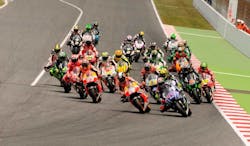Catalan MotoGP debrief with Masao Azuma
Last weekend’s Catalan Grand Prix at Circuit de Barcelona-Catalunya was one for the ages, with a thrilling three-way battle for victory between Repsol Honda’s Marc Marquez and Dani Pedrosa, and Movistar Yamaha MotoGP’s Valentino Rossi producing one of the most exciting encounters in recent years.
Ultimately it was Marquez who claimed victory to extend his perfect record in 2014, with Rossi finishing second and Pedrosa third.
After a hot start to the weekend, temperatures cooled down on Sunday with a peak track temperature of 40°C recorded during the twenty-five lap Catalan Grand Prix.
Q&A with Masao Azuma – Chief Engineer, Bridgestone Motorsport tire Development Department
Temperatures on Friday and Saturday were extremely hot, but then we had a cool change on Sunday. Did this have an effect on race tire choice for riders, and how did it affect tire performance?
“Although it was cooler on Sunday, this didn’t have a big influence on race tire choice for riders. With the lack of grip from a track surface that has been heavily utilized for racing, many riders said that the soft and medium rear slicks were working best as they needed the maximum amount of edge grip to be competitive. As a result, no matter what the weather brought on Sunday, almost every rider made up their mind on Saturday which tires they would use for the race, in the end there were only a couple of late decisions made on the grid regarding which tire to use. As for tire performance, the cooler temperatures probably helped as it reduced the potential for the rear tire to overheat due to spinning. We had a new Circuit Record Lap and overall race time record set during Sunday’s race, so it seems the cooler temperatures allowed the riders to extract maximum performance out of their slick tires.”
Many riders complained about the grip level of the Circuit de Barcelona-Catalunya. Considering the lack of grip, are you happy with tire performance over the race weekend?
“Yes I am happy with how our tires performed and believe that our tire allocation had the best balance of grip versus durability. I think our expanded front tire allocation has allowed riders to better deal with unpredictable track surfaces, but at such a severe circuit for tires such as the Circuit de Barcelona-Catalunya we cannot go too soft with our compound allocation as this would affect the durability and heat-resistance of the tires. At the moment, I think our balance of compounds is working well for the track, as we had record pace over the weekend despite the grip level being sub-standard. However, I heard it was a possibility that the circuit might be resurfaced soon and I think this would be the best option for everyone, as it will improve the grip level of the circuit and also remove the bumps in the braking zones entering the corners, which will make the track safer and more predictable for the riders.”
You provided a new tire for riders to test at the post-race test at Circuit de Barcelona-Catalunya. What is this new tire and what benefits are you expecting it to provide?
“The new tire we provided was a front slick using a newly-created compound that we developed following requests from the riders. This new compound sits roughly halfway between our current medium and hard compounds in terms of hardness, and is best suited to circuits which are quite severe for tires with hard braking zones.
“We expected that this new front slick compound would provide the same high level of braking stability as our current hard rubber compound, but with cornering performance closer to that of our medium compound. Many riders tried this new front slick compound in the Monday test at Montmeló and said it was in improvement over our current hard compound so this is promising news. We will now cross-reference their feedback with the empirical data we collected during the test and make a decision on whether we will introduce this new compound later in the year.”
